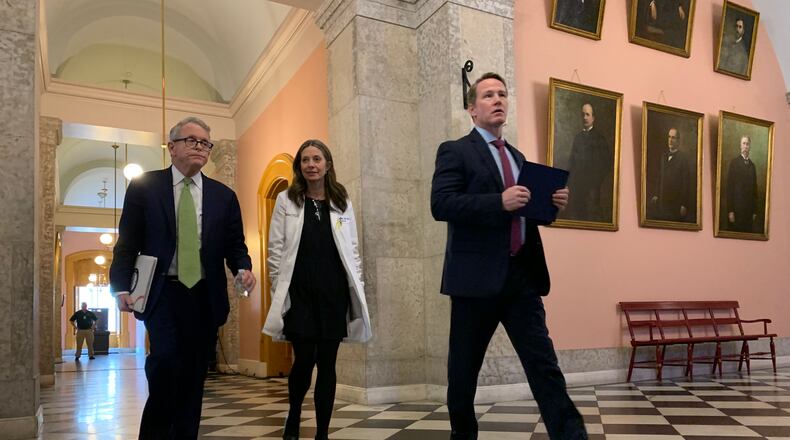But people are still dying, front-line workers lack enough personal protective equipment and the need for social distancing continues, he said.
“You are succeeding — but the second you ease back, we’ll see ourselves in an outbreak that will really overwhelm our health care system,” health department Director Dr. Amy Acton said.
>> Coronavirus: Complete Coverage
DeWine took early action last month by closing schools, moving college courses online, stopping visits in prisons and nursing homes, shutting bars and restaurants. All these moves were designed to slow the spread of the deadly virus and flatten the pandemic curve to make sure the healthcare system isn’t overwhelmed.
With no mitigation, Ohio would have seen 62,000 cases a day at the outbreak’s peak, Acton said. As Ohioans practiced social distancing, the peak prediction shifted to 10,000 new cases a day. The latest model forecasts 1,600.
“You have squashed this and you have stretched it. Honestly, this is you, this is what you have done, this is how you have saved lives,” Acton told Ohioans watching the governor’s daily press briefing.
She said if the trends hold, Ohio may not run out of ventilators, may not need as many extra hospital beds and will be able to shift key equipment to hot spots that break out across the state.
1 - This is our initial model.
— Governor Mike DeWine (@GovMikeDeWine) April 8, 2020
2 - Our current model.
YOU have squashed this and stretched this curve. But please know that if you start going out, well go right back up. You have to keep doing what you're doing. pic.twitter.com/uADFqpMSXV
The DeWine administration has relied on models from Imperial College in Britain, the Cleveland Clinic and Ohio State University’s Infectious Diseases Institute. Models forecast what is expected to happen based on available data and the timing of and adherence to mitigation strategies such as stay-at-home orders.
OSU is expected to release a white paper on its model this week.
>> DeWine & Amy: The popular pair have a theme song and video, thanks to Ohio animator
On Wednesday, the Ohio Department of Health reported 5,148 confirmed coronavirus cases statewide, including 1,495 hospitalizations and 193 deaths.
Among the fatalities is John Dawson, 55, who worked as a corrections officer at Marion Correctional Institution since 1996. So far, 48 employees and 17 inmates in seven state prisons have tested positive for the virus. Dawson was the second Marion employee to test positive.
Acton said ODH is urging patients to volunteer race and ethnicity data so there is a more complete view of how the disease is hitting Ohioans. In 37% of cases, ethnicity is unknown and in 22% of cases race is not reported.
As in other states, it appears COVID19 is killing blacks at a disproportionate rate. Black Ohioans, who make up 13% of the population, account for at least 19% of cases and at least 27% of deaths.
A call for available ventilators and other key medical equipment brought offers of 901 vents, 2,153 CPAP machines, 978 BIPAP machines and 577 anesthetic machines, the Ohio Department of Health reported this week.
DeWine also announced Wednesday that the Bureau of Workers’ Compensation will send up to $1.6 billion in dividends to Ohio employers this spring to ease the impact of the coronavirus crisis.
“For those employers, it means one less bill to worry about. As in previous years, the dividend is possible due to strong investment returns on employer premiums, a declining number of claims each year and prudent fiscal management,” DeWine said.
RELATED CONTENT:
>> 3 more coronavirus cases confirmed in Middletown, total now at 13
>> Coronavirus: Pandemic could lead to outbreak in scams, Ohio AG says
>> Coronavirus: Montgomery County property value dispute deadline extended
>> Which Dayton-area restaurants are offering Easter dinners to go?
>> Coronavirus: Cloth masks no substitute for social distancing, Public Health commissioner says



